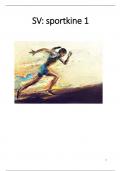Summary
Sportkinesitherapie 1 samenvatting: theorie, praktijk en te kennen artikelen
- Course
- Institution
Zowel de theorie- als de praktijklessen zijn samengevat in dit document. Daarnaast zijn ook de te kennen artikelen samengevat toegevoegd. Ook worden er belangrijke stukken voor het examen aangeduid.
[Show more]



